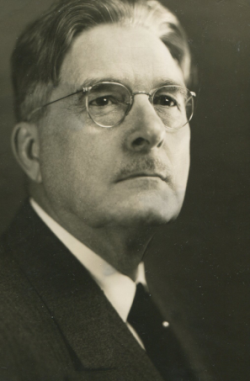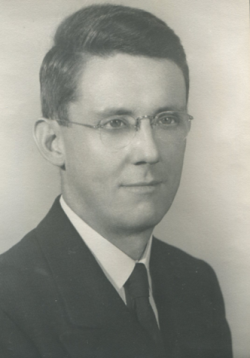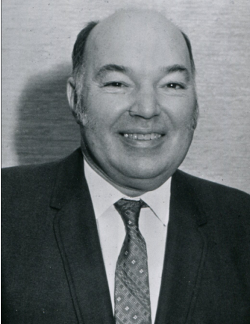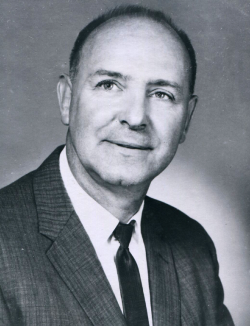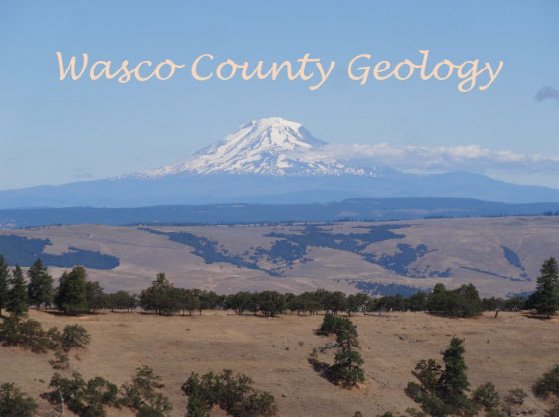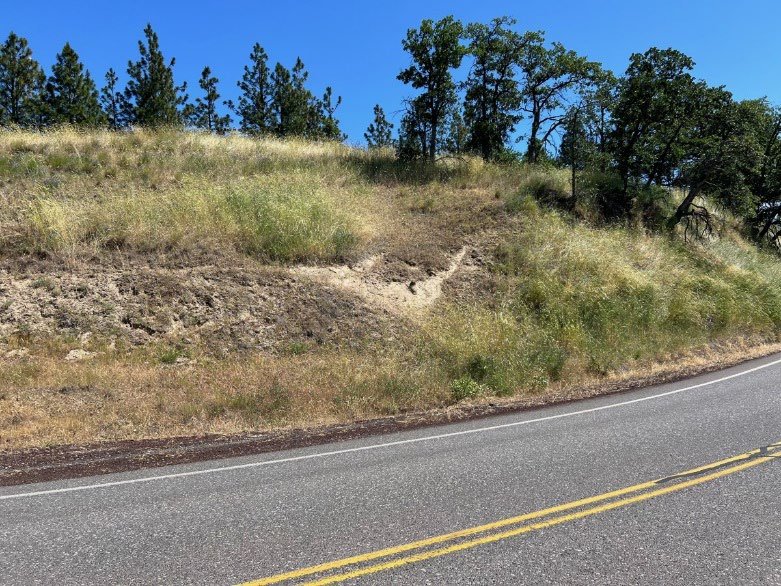GSOC Past Presidents
This archive was compiled by Carol Hasenberg in 2015 and subsequently revised and updated in 2024. Carol has included all the material from the GSOC archive books, as well as references to other parts of the GSOC archives and personal recollections. Rather than creating only a list of individuals and their separate stories, she has attempted to frame the GSOC presidents by the state of the GSOC society during particular eras and its relationship to the profession and the society at large. She hopes that future society members and archivists can benefit from this work.
Archive Book One - The Formative Years: 1935-1969
Title page of the first archive book written in the 1960’s
The physical book is part of the historic GSOC archives, and has been scanned and collected into a series of web archive pages.
The Society was organized in 1935 with Dr. Edwin T. Hodge, geology professor at the University of Oregon, as its first president. Dr. Hodge made special trips to Portland to conduct classes in the fundamentals of geology. Many of these students became charter members of the Society. The society’s first roster contained 66 members, both men and women. By 1945 the membership had swelled to about 150 people, and by 1950 over 200 GSOC members were listed.
During this period, GSOC members, especially Dr. Hodge, were involved in the creation of the Oregon Museum of Science and Industry, now known as OMSI. The museum became a reality in 1946. GSOC held its lectures and maintained a library at OMSI 1969-1971, after which the two organizations went their separate ways. Prior to the OMSI space, the society held its functions at a variety of public venues, including the Multnomah County Library, Portland Chamber of Commerce, and the Public Service Building.
One of the most interesting things you may want to search for in the old issues of The Geological Newsletter is the history of the society with respect to the “Spokane Floods” theory by J. Harlan Bretz. Our society founder Dr. Hodge was more in the uniformitarianism camp and disagreed with Bretz regarding the source of the water and the amount of time it took to carve the features of the scablands of Eastern Washington. Refer to his detailed description of his theory in the April 1938 edition of the newsletter. He probably never changed his mind on his position (see March 1955 edition for his comments), and it wasn’t until April 1965 that a more favorable article was penned by Irma Sullivan on acceptance of Bretz’ refined and corroborated theory. (Although a 1952 field trip report referred to trip leader and GSOC member Lloyd Ruff attributing Mosier gravel deposits as being made by the Spokane floods.)
During its formative years the society served as an organization for professional geologists and professionals and civic leaders in related fields, and also a social club. Take a look at the presidential list for these years. It includes some highly respected professional and amateur geologists in the Pacific Northwest.
Bear in mind when reading the presidents' bios (by clicking on their photos) that these were written at the time that the books were assembled and usually authored by each president. So information written as "current" is not current today but current at the time of writing.
Archive Book Two - The Golden Age: 1970-1991
The presidents depicted in the second GSOC archive book reflect the many great changes that were occurring in society in the latter half of the Twentieth Century, and also the greatest revolution in geology since the inception of the science as well. Although some rather jesting comments were made about Continental Drift Theory in the 1952 volume of The Geological Newsletter, a serious article outlining the various types of evidence for the theory was not written until the “Only a Stone’s Throw” article written in May 1956 by Ralph Mason, our 1967 GSOC President. The acceptance of this theory must have been reflected on the careers of many geologists at the time.
It is also evident that women began taking more pronounced leadership roles in GSOC. The leadership of Ruth Hopson Keen was well-remembered by the members of the society into the Twenty-first century, and they were fond of telling stories about her no-nonsense style of leadership in my first years in the society (which began in 1995). It is also true that many of the early female presidents of GSOC were wives of GSOC Past Presidents. There are three such pairings in this group of presidents - the Keens, the Obersons, and the Kenneys.
The time in which this book starts was a “golden age” for GSOC. The 1970 roster listed 337 members, and The Geological Newsletter lists 13 activity committees. Lectures were conducted at OMSI, as well as “luncheon meetings.” The society acted as a strong amateur and related fields social club, but also did contain many geological professionals. The membership focused on nuclear families with largely male leadership, although a number of singletons were members of the society. President’s Campouts often lasted for a week and were well attended. After the rift with OMSI in 1971, GSOC conducted its lectures at Portland State University, and as of 2024, the society’s lectures, library and archives are still maintained there.
Late 20th Century and Early 21st Century Society Presidents: 1992-2005
The last surviving GSOC Charter Member Mildred Phillips attended the GSOC annual banquet before her death in 2001. She was born February 11, 1905.
This was a difficult time in the history of the society. The “golden age” population of the society had aged considerably, and the leaders who remained were finding it difficult to attract younger people to join. Clay Kelleher often joked that when he joined the society in 1984, he brought down the average population by 10 years.
Fortunately, some of the members recognized the problem and set about to correct it. The two people spearheading this effort were Bart Bartels and Bev Vogt. Bev recruited me for the board of directors as Vice President at the annual banquet in March 1998. At that time, board members on the “Presidential Track” became VP, then President the following year, and then remained on the board for the next two years as Past President. Also, the VP was responsible for engaging Friday night lecturers, and the President was responsible for organizing the President’s Campout. This put a lot of work on the shoulders of the presidential candidates, and it was very difficult to find candidates. Bev sweetened the pot by telling me that she had already lined up most of the speakers for the following year from the USGS CVO office in Vancouver. So, I agreed to jump in feet first.
Even so, it took a number of rocky years for the society to turn the tide. It was difficult to recruit board members who were committed to rebuilding the society to honor its mission. There was also a lot of resistance amongst the retired membership to create a website or a presence on the nascent social media outlets to attract student members. Nevertheless, a core of committed members soldiered on and kept the main activities of the club, the field trips, newsletter and Friday night lectures, viable until the next generation began to arrive.
I feel that when Janet Rasmussen joined, the society finally began to solidify. Janet has a magnetic personality and she started to attract other members to the society and a larger group of people were helping with the tasks needing to get done. Her husband Doug also was very supportive of her efforts. And I would also like to remember the efforts of Rosemary Kenney, Phyllis Thorne, Marvel Gillespie, and Tom and Diana Gordon, all of whom also played major roles in the society during the difficult years in addition to the presidents listed below.
Another happening that may have sparked renewed interest in geology in the Pacific Northwest was the discovery of the Cascadia Subduction Zone, and its destructive earthquake and tsunami history, in the late 1980’s and early 1990’s. You can find the first reference to these phenomena in the February 1990 edition of The Geological Newsletter, in a 1978 article by Dr. John Eliot Allen. The potential for magnitude 9 earthquakes greatly changed the focus of many geologists from stratigraphy and mining to geohazards during this time and bolstered the creation of disciplines to mitigate the hazards. The nature of the hazards were then brought home to the general public by the 2004 Indonesian and 2011 Japanese subduction zone quakes. Also, a number of smaller crustal quakes in Oregon and larger ones in California in the 1990’s and the 2001 M 6.8 Nisqually quake in Washington state were warning signs that geoscientists and engineers could not ignore.
Rebuilding the Society: 2009-2024
These years represent many changes in the way the society operates, and an influx of new members. Another key member joined the society at the beginning of this period - Paul Edison-Lahm. Paul is a gifted communicator with skills in computer communication and graphics. He replaced Bev Vogt as society secretary, and one of the first projects he embarked upon was rebuilding the GSOC website on the Squarespace platform. This greatly expanded and constantly updated website got the notice of younger enthusiasts and newly retired folks.
Another key member, Sheila Alfsen, joined the society during this period. Sheila combined professional geology and education in her work with GSOC and made it possible for many non-geologists to become familiar with the basics of Oregon geology. She has taught geology at several of the community colleges, and taught geology classes for GSOC. She has also led several GSOC field trips, including those to Mary’s Peak, the Willamette Valley transect, and the Cascade Mountains in Oregon.
Several of the members that also joined the society around the late 2000’s and helped to rebuild are Dawn Juliano as Treasurer, Larry Purchase as board member and field trip organizer, Dave Olcott as field trip organizer, Jan Kem as business manager, and Rik and Barbara Smoody. Rik became GSOC president twice.
The difficulty of finding presidential candidates and a lopsided division of work on the board of directors prompted some of the board members to start thinking about revising the bylaws around 2018, during Paul Edison-Lahm’s presidency. Paul, Carol Hasenberg, and new treasurer Barbara Stroud rewrote a draft of the bylaws to include four officers, five managing directors (communication, programming, field trips, grant and outreach, and membership) and 2-4 members at large. The new bylaws took about a year to become ratified in the society’s procedure and is the model used as of 2024.
Another needed change in the way the club did business was managing its members, including collecting yearly dues and registering members for events. Paul Edison-Lahm and Barbara Stroud researched the available software and then chose the Wild Apricot membership platform. Paul coupled the public pages of this platform with the Squarespace website, and Barbara uploaded all the membership data from Excel files into the new membership database. This was a monumental task and it was completed about the same time as the newly organized board of directors was confirmed.
All these changes to the business side of the society took place just as the COVID-19 pandemic was getting started. After having to cancel the 2020 GSOC annual banquet at the last minute, President Sheila Alfsen and the board had to decide about whether to try to catapult the society into the online meeting space for however long the lockdown was going to last. A trial Zoom meeting of the board of directors took place on March 24, 2020, and from there it was decided to try a presentation.
Our first online GSOC meeting took place on April 18, 2020, with Sheila doing the presentation “Assembling Oregon Geology”. This can still be viewed in the GSOC video archives. The move to have meetings online proved to be a wise decision. GSOC in-person meetings did not resume until April 2022, two years after the initial lockdown. Meanwhile, the membership, geographical reach and depth of programs of the society continued to increase, and as of 2024, we have over 400 members.
One other development occurred during President Clark Niewendorp’s tenure in 2021. The society decided to increase its involvement and support of the Portland State University (PSU) Geology Department. The board approved the development of a scholarship fund with a GSOC scholarship committee choosing the recipients of $1000 awards to PSU graduate students. The committee also provides smaller stipends to students helping with GSOC’s Saturday morning programs and other society events. After Bev Vogt’s death in 2021 the fund was named in her honor, and GSOC Outreach/Grants Director Carole Miles has headed the scholarship fund committee.
During this period USGS and Oregon geologists have continued to unravel the tectonic history and future of the state. Ray Wells of the USGS and others have authored important papers on the tectonic state of Oregon. DOGAMI and Oregon universities have made important findings on earthquakes and landslides in the state, especially since the advent of LiDAR mapping, made available to Oregon geoscientists through the work of Ian Madin of DOGAMI. Also, volcanologists have made great strides in analyzing the origins of the many types of volcanic lava covering the state to reveal the parts played by changing states of the North American leading edge subductions zones, the Yellowstone hotspot, and other mechanisms.







